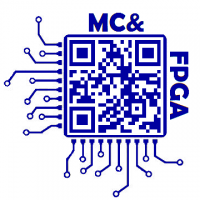Designing the Structure of a General-Purpose Telemedicine Complex
Valerii Semenets, Valeriia Chumak, Iryna Svyd, Oleg Zubkov, Oleksandr Vorgul, Natalia Boiko
III International Scientific and Practical Conference Theoretical and Applied Aspects of Device Development on Microcontrollers and FPGAs (MC&FPGA), Kharkiv, Ukraine, 2021, pp. 47-48.
Abstract
Taking into account modern trends, the analysis of the construction principles of telemadic systems, networks and complexes is presented in the work. The general structure of providing telemedicine services is developed. Structures of realization of portable and mobile telemedicine complexes are offered. Infocommunication systems and networks for implementation in mobile telemedicine complexes are analyzed. The advantages of using the sensor mobile body area network of the IEEE 802.15.6 WBAN standard in mobile telemedicine complexes are justified.
Keywords: telemedicine, telemedicine complex, medical services, device structure, microcontroller, sensor network, wireless sensor body area network.
Full Text: PDF
References
- E. Krupinski, “Telemedicine Workplace Environments: Designing for Success”, Healthcare, vol. 2, no. 1, pp. 115-122, 2014. doi: 10.3390/healthcare2010115.
- B. Kreofsky, R. Blegen, T. Lokken, S. Kapraun, M. Bushman and B. Demaerschalk, “Sustainable Telemedicine: Designing and Building Infrastructure to Support a Comprehensive Telemedicine Practice”, Telemedicine and e-Health, vol. 24, no. 12, pp. 1021-1025, 2018. doi: 10.1089/tmj.2017.0291.
- “A Java-based general purpose telemedicine system”, International Congress Series, vol. 1256, p. 1302, 2003. doi: 10.1016/s0531-5131(03)00257-7.
- Чумак В.С., Свид І.В. “Реализация структуры нейронных сетей на FPGA”, Наука, технології, інновації: тенденції розвитку в Україні та світі: матеріали міжнародної студ. наук. конф., 2020. – Харків, Україна: Молодіжна наукова ліга. –Т.2– С. 30-32.
- I. Svyd, O. Vorgul, V. Semenets, O. Zubkov, V. Chumak and N. Boiko, “Special Features of the Educational Component Design of Devices on Microcontrollers and FPGA”, MC&FPGA-2020, 2020. doi: 10.35598/mcfpga.2020.017.
- O.G. Avrunin, T.V. Nosova, V.V. Semenets. Basics of VDHL language for designing digital devices on FPGA: a textbook. Kharkiv: KNURE, 2018. – 196 p.
- В. Чумак, І. Свид. “Створення модуля VHDL-опису при проектуванні цифрових систем на ПЛІС в Xilinx ISE Design Suite”, Перспективні напрямки сучасної електроніки, інформаційних і комп’ютерних систем (MEICS-2019), 27-29 листопада 2019 р., м. Дніпро, Україна, 2019, С. 94-95.
- V. Semenets, “Technical aspects for development laboratory base for learning FPGA and microcontroller systems.”, in 10th International Conference The Experience of Designing and Application of CAD Systems in Microelectronics, Lviv-Polyana, Ukraine, 2009, p. 145.
- O. Vorgul, O. Zubkov, I. Svyd and V. Semenets, “Teaching microcontrollers and FPGAs in Quarantine from Coronavirus: Challenges and Prospects”, MC&FPGA-2020, 2020. doi: 10.35598/mcfpga.2020.005.
- Z. Oleg, I. Svyd and O. Maltsev, “Features of the use of PID controllers when controlling evaporators”, MC&FPGA-2020, 2020. doi: 10.35598/mcfpga.2020.001.
- HusonM. L.; Sen A. Broadcast scheduling algorithms for radionetworks / Military Communications Conf, IEEE MILCOM. 1995. V.2, P. 647-651.

